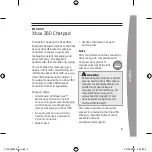
4
On these instructions
The following symbols and marks are used in these instructions:
1. Action instructions are numbered consecutively.
✓
Results of actions are identified by this check mark.
• Enumerations are identified by this point.
How the room temperature controller functions
Your room temperature controller functions similarly to a time delay
switch – at specific times which can be set, your heating system is
regulated by the room temperature controller to three temperatures
which can be set.
• The comfort temperature is usually used for the daytime, put more
precisely for the periods when you are present.
• The lowering temperature is usually used for the night. It is also called
the economy temperature.
• The anti-freeze temperature is usually used for longer periods of
absence (e.g. holidays). The temperature is just high enough to protect
the heating system against freezing.
Starting up the room temperature controller
When the room temperature controller is switched on for the first time as
well as after long deactivation periods, e.g. after a power failure, the room
temperature controller jumps automatically to the time input - the current
data
has to be
entered here.
(you can edit these data later --> for further information please refer to
”Setting the date and time – Uhr menu item” on Page 7).
✓
The hour display flashes
1. Press the
+
or
-
button until the desired
hour has been set.
2. Press the
S
button.
✓
The hour is set and the minute display
flashes.
3. You now have to enter all the further data
in the same manner:
• Minutes
• Calendar year
• Month
• Day
4. Confirm each entry with the
S
button.
✓
After the last confirmation with
S
, the system returns automatically
to the normal display.
i
Note!
Information on the economical use of the room temperature controller is
identified by this sign.
i
Time format
You can have the time displayed in international 24 hour format
(0H...23H) or in the English-speaking a.m. (12AM...11AM) and p.m.
format (12PM...11PM). When you set the clock,
the display
begins with
the 24-hour format, followed by the AM/PM format. Depending on the
hour format which you confirm with
S
, the time is displayed in future
in 24-hour format or in
A
M/
P
M format.





































